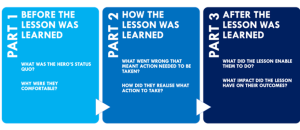The power of using stories in sales is pretty well known, however, they are way more impactful right now than ever before. In this post we want to explain why and share three tips on how to best to use them. Spoiler alert: in the process, we might just ruin all of your favourite films…
Let’s start by getting into our client’s shoes and working out why they need stories right now:
- More than ever- clients are looking to make safe decisions. They need to trust that whatever you’re selling is going to work. Now facts and figures, stats- they’re all good but they don’t create a visceral, emotional response that drives change- stories do…
- Many clients are really unsure what they should and shouldn’t be doing. They want to learn. Stories are a great way to teach.
- The number one thing that our clients want to learn about right now is what their audience are up to- share stories around that and you’re in a great place
So here are three tips on how to best to use stories right now:
- Don’t tell stories about why they should choose to work with you. Here’s why:
- That’s basically a story about how great you are- no one wants to listen to that
- Everyone else is doing it- its a case study
- A client needs to be taught why they should move from their status quo before you teach them why they should choose you
- Teach them a lesson. This should be a lesson that encourages them to think and act differently now. Once they’ve realised that, you can start to tell them why they should consider working with you
- The marketing approach you take right now with clients will be remembered forever and shape the future relationship
- The way audiences engage with digital has changed forever
- The marketing messaging the audience needs has changed

- Use a three-stage process (spoiler alert- all of your favourite films pretty much follow this structure)
Here’s an example story where the lesson that we want to teach our client is: ‘Online learning products have become even more impactful because the way that learners are interacting with online platforms has been transformed’.
Part 1: Before the lesson was learnt
I was talking to a [insert job title] who works in a business very similar to yours. Traditionally, they have favoured face-to-face workshops and they were a little dubious as to whether online learning could have the same impact- they’d experimented with it some years ago and the results hadn’t been great. That wasn’t a problem for them pre-outbreak as they had a nice rolling programme of face-to-face workshops.
Part 2: How the lesson was learnt
Unfortunately, the current lockdown kicked in just a couple of weeks before a major change in legislation that was going to have a big impact on their business. They needed to roll out a lot of compliance training and were forced to look at online alternatives to face-to-face workshops. They engaged with their staff as part of their due diligence and they found that there had been a fundamental change in the way their staff perceived online engagement and learning. Even over the first couple of weeks of lockdown, their staff told them that they were much more receptive to training delivered remotely. When they dug into the staff survey, it became clear that Zoom calls with family and friends, weekend drinks over Houseparty and routinely communicating with colleagues on Hangouts had fundamentally changed their perception of online learning.
Part 3: After the lesson was learnt
That insight gave them the confidence to really embrace online learning. The result was that they were able to deliver the compliance training more quickly to more of their staff. On top of that they did it more cost effectively and the learner feedback was more positive than ever.
Want to know more about using stories in sales?
To find out more about using stories in sales, get in touch or follow us on LinkedIn.
